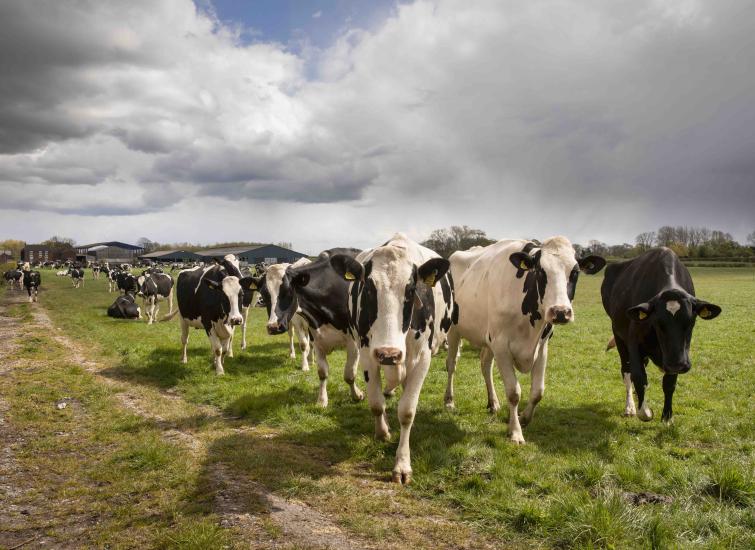Advanced Robot have helped us transition onto the automated milking system with impressive results. The team has a clear understanding of how the whole system needs to work, from the cow and her health right through to the robot settings. The cows are healthy and performance is terrific.
Preparing for Spring Turnout
Grazed grass is the cheapest feed available on the farm, so there is a compelling argument to optimise its use. So what can producers do to maximise its potential in the early part of the season as they turn out their herd? British Dairying finds out.

Successful grazing is as much an art as a science, being at the mercy of the weather, there are some things we can control and plan. Transitioning dairy cows from being housed to grazing requires careful management to prevent nutritional imbalances, negate milk production losses and maintain animal health.”
To optimise any grazing system, a comprehensive approach is essential. Will Tulley and his team advocate for a whole-farm perspective, not just focusing on diet but also considering the cows' environment and management. The foundation for success lies in the management plan, starting with pre-season preparation.
Will explains, “We should be looking at the maintenance and repair of the grazing infrastructure which includes fences, cow tracks and water troughs, before turnout, as this will save headaches and hassle later in the year. Whilst having paddocks has many advantages, electric fencing is cheap and versatile. Walk the fields ahead of turnout and measure covers, this allows you to plan which areas will be grazed first. Assessment of the sward composition and how open they are will allow decisions around overseeding or re-seeding to be made.”
“Strategic grazing of sheep over the winter can be a useful tool for managing areas with heavy grass cover, in addition to being a source of income. However, sheep should be removed once a pasture cover of 1,400kg DM/ha is reached and certainly by the end of January otherwise spring re-growth will be compromised.”
“Plan a robust parasite management plan in conjunction with your vet. Flies will disrupt grazing behaviour and increase the risk of infectious disease in all groups of cattle. Endoparasites are of particular importance in younger animals.”
Planning is essential
Will also advises farmers to plan which animals they intend to graze. “This will be herd specific. For many herds, particularly spring and autumn block calving herds it will be the whole herd. For other herds it may be lower yielders and pregnant cows, with fresh cows housed. It may be decided that fresh cows graze for eight hours a day. Many factors will contribute to this decision including expected milk yield, contract requirements, grazing availability, management system etc. A huge area of debate but we should all agree that it needs to be planned! Lame cows should not be expected to walk long distances to graze, either keep them housed or have a small paddock adjacent to the dairy.”
When it comes to turnout, Will suggests that a transition period is desirable. “Allow cows around 4kg DM/day grazing initially and work up to their full allocation over a 1-2 week period reducing the amount of buffer feed accordingly. This allows a period of rumen adaptation and gradual dietary change.
Early turnout grass has a very different nutritional composition, for example it typically has low fibre and a high sugar content compared to winter forages. Complimentary fibre and/or buffer feeds can effectively balance the nutritional profile by optimising fermentation in the rumen.
“Capturing as much rumen nitrogen as possible, (from the breakdown of grass protein), also serves to increase the nitrogen efficiency of the herd - another metric coming under increased scrutiny. We should therefore not just accept that milk quality will be compromised when cows are turned out, particularly those who are paid favourably for milk solids.
“Similarly the mineral requirements between grazing and winter housing will differ. Of particular importance in the short term is ensuring adequate Magnesium provision in the prevention of grass staggers. Trace element provision should also be reviewed to ensure animal requirements are being met. It is important to remember that soil mineral analysis don’t correlate very well with herbage mineral levels and so grass mineral levels should be used when evaluating animal requirements.”
Continually assess strategy
Once you have decided which cows are going to graze (and therefore how many animals) you can then plan on how much pasture to allocate per day to achieve your desired residual. As an example, say we want to graze 250 animals with a DMI of 10kg of grass – If our starting cover is 2700kg DM/ha and our residual is 1600kg DM/ha then we would allow 2.27ha/day. Achieving target residuals is a fundamental part of successful grazing as it ensures the quality of regrowth. However, it could be argued that forcing high yielding cows to graze this low may compromise intakes. In this case it may be beneficial to target higher residuals with the milking herd but ensure residuals are met by immediately following the herd with other classes of stock, such as pregnant heifers for example.”
A pro-active approach is key to a successful transition of dairy cows from a housed diet to grazing. Recognising the variability of each grazing season, farmers must continually reassess their grazing strategy, closely monitoring grass growth rates and availability on a weekly basis. This diligence ensures a well-informed and adaptable plan that aligns with the evolving needs of the herd.
“We cannot emphasise enough the importance of meticulous planning, incorporating fieldwork and veterinary plans to address potential parasitic challenges. Moreover, it's essential to acknowledge the individualised dietary preferences and grazing efficiency of different breeds, steering away from a one-size-fits-all mentality. Rather than reacting to issues as they arise, a forward-thinking and customized approach to transitioning dairy cows to a grass diet will contribute to overall farm sustainability and success,” concludes Will.
〈 BACK



